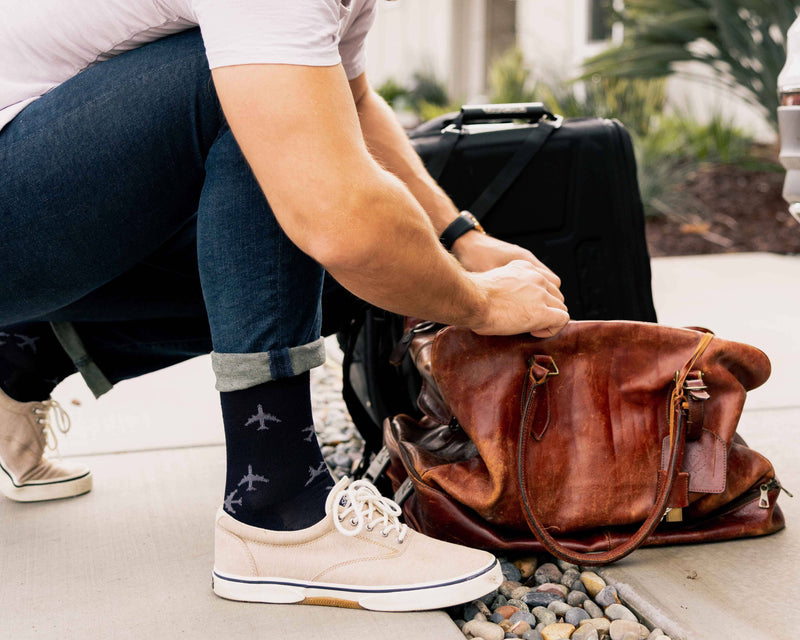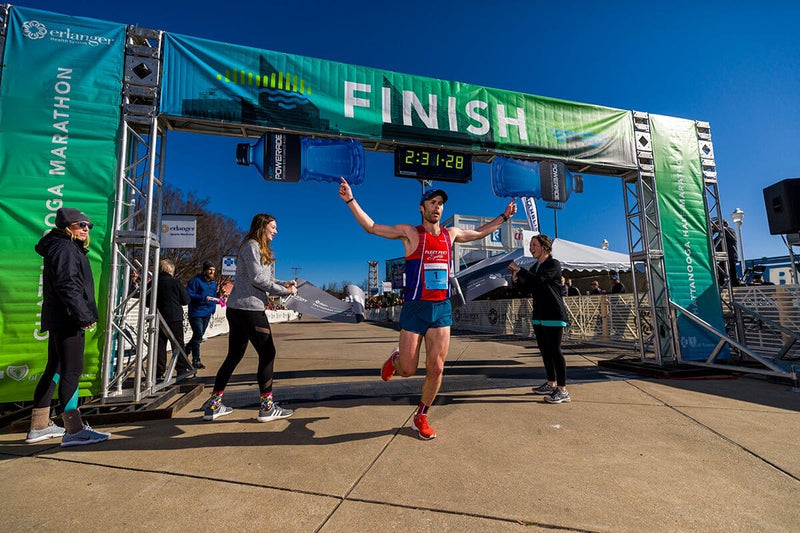
Feeling like your legs have run a marathon even though you've barely left your desk? Compression socks can help, but with terms like “mmHg,” choosing the right pair might seem tricky. Don’t worry—we’ll simplify it and help you find the perfect compression level for your needs, whether you’re an athlete, traveler, or just want to avoid leg fatigue.
Key Takeaways
- mmHg, or millimeters of Mercury, indicates the pressure level of compression socks, crucial for improving circulation and reducing leg fatigue and swelling.
- The main levels include mild (8-15 mmHg), moderate (15-20 mmHg), firm (20-30 mmHg), and extra firm (30-40 mmHg), each serving different needs.
- Determine the appropriate compression level based on personal needs and consult a healthcare professional, especially for specific medical conditions, to ensure effective and safe use.
- The right mmHg level in compression socks ensures comfort and health benefits, with mild pressure (8-15 mmHg) for daily use, moderate (15-20 mmHg) for travel, firm (20-30 mmHg) for sports recovery, and extra-firm (30-40 mmHg) for medical conditions.
- Compression socks offer great benefits, but they may not be suitable for those with specific conditions like arterial disease, making it vital to consult a healthcare provider first.
The Basics Of Compression Socks
Who knew socks could do more than keep your feet warm, right? Compression socks promote better circulation and can soothe tired, achy legs. Let's explore the world of mmHg, the magic number behind these comfy wonders.
What Does mmHg Mean in Compression Socks?
mmHg stands for millimeters of Mercury and, brace yourself, it's the same unit used to measure blood pressure! In the world of compression socks, it tells you about the pressure level your socks are giving your legs. If you've ever squeezed a rolled-up tube of toothpaste, it's kinda like that—more pressure at the bottom, easing up as you go. This helps with circulation, keeping your legs feeling lively and less like overcooked noodles.
How Compression Levels Work
Compression socks apply pressure, measured in mmHg, to give your legs a circulation boost. The pressure is strongest at the ankle and gradually eases up as it moves up the leg. Compression levels range from mild (8-15 mmHg) to moderate (15-20 mmHg) and firm (20-30 mmHg), each serving a different need. Selecting the right level depends on your health needs, so it's always smart to check with your healthcare provider for the best fit.
Guide To Compression Socks mmHg Levels
Choosing the right mmHg for compression socks sounds like picking a number out of a hat, but it's more scientific than that. Consider your needs, and let’s walk through the range of compression levels.
Mild Compression: 8-15 mmHg
This level of compression is like a gentle hug for your legs. It softly promotes circulation, helping reduce that annoying mild swelling in your feet and ankles. And if standing all day is your jam, these socks are your new best friend. They keep the tired, aching feeling at bay.
Pregnant? Say goodbye to early spider veins. These socks wrap around you with support and love. Mild compression is also perfect for anyone just dipping their toes—literally—into the world of compression socks.
Moderate Compression: 15-20 mmHg
Moderate compression steps up to alleviate those tired, achy legs. Suitable for newbies in the compression world, it’s ideal if you've got minimal swelling or mild venous insufficiency trying to cramp your style.
Consider this compression level as your personal leg-support assistant. Whether you're running a marathon or chasing your toddler, these socks ensure your legs stay comfy and keep on strutting.
Firm Compression: 20-30 mmHg
Firm compression is where things get seriously supportive. Ideal for managing moderate swelling or pesky varicose veins, this level is like having a mini leg massage all day.
This compression is the real deal for medically significant issues. It’s like having a relentless cheerleader that keeps your leg circulation game strong. So if your lifestyle demands firm support, these socks have your back—or rather, your legs.
Extra Firm Compression: 30-40 mmHg
Ready for the heavy hitters? Extra firm compression means business. Designed for serious symptoms like severe swelling or post-surgical comfort, these socks are your secret weapon for promoting better circulation when things get tough.
Consider these socks your legs’ bodyguard, ready to jump in when needed with strong support. Dive into this level, and you'll feel the intensive care and consideration crafted into every pair.
Factors To Consider When Selecting Compression Socks
Comfortable, supportive, and stylish—compression socks are versatile companions in your health journey. Deciding on the right mmHg, though, is crucial for effectiveness and comfort.
Determining Your Needs
Leg fatigue, minor swelling, or pesky varicose veins might be your kryptonite. Mild compression (8-15 mmHg) keeps leg tiredness at bay and gives those weary limbs a gentle hug. If you’re battling chronic leg fatigue or more persistent swelling, moderate compression (15-20 mmHg) swoops in for the rescue. Perfect for professionals on their feet or travelers with wanderlust!
Consulting a Healthcare Professional
For compression sock selection, nothing beats a seasoned sidekick—your healthcare professional (we’re talking less cape and more stethoscope here). Skip self-diagnosing because a quick chat with a trusted expert helps ensure you’re not going too tight or too loose. Especially if you’re dealing with specific medical conditions, an expert ensures you accessorize those legs just right!
Best mmHg For Compression Socks Based On Needs
Finding the right compression level is key to maximizing comfort and health benefits. Whether you're zipping around all day or lounging on the couch, there's a compression sock for you.
Daily Wear and Mild Relief (8-15 mmHg)
This gentle hug is just what the doctor ordered—literally. Perfect for keeping fatigue at bay during that epic TV binge you promise will just be one episode. Great for standing, sitting, or simply existing, they promote circulation and prevent minor swelling. Even moms-to-be can say goodbye to varicose veins making secret leg appearances!
Travelers and Office Workers (15-20 mmHg)
Your ticket to fresh, ache-free legs. Ideal for wandering travelers or desk-bound warriors who dream of standing desks, but deal with reality. These socks help banish that afternoon leg slump while reducing the risk of deep vein thrombosis. No more leg woes during long flights or marathon days at work.
- Recommended for Men: Sockwell In Flight Compression Socks
- Recommended for Women: Sockwell Field Flower Compression Socks
Athletes and Recovery (20-30 mmHg)
Got a love-hate thing with workouts? These socks got you. Helping with circulation and muscle recovery, they’re like your very own cheerleader, minus the pom-poms. Ideal for athletes, weekend warriors, or anyone who believes life is better in motion. Feel the zing and bounce back faster from soreness.
- Recommended for Men: Sockwell Tartan Compression Socks
- Recommended for Women: Sockwell Twinkle Compression Socks
Severe Swelling and Medical Conditions (30-40 mmHg)
Heavy hitters for serious support. They’re focused, committed, and never skip leg day. Cranking up the pressure, they're here to assist with severe swelling or medical conditions. Consider these if you need more support for tasks like post-surgery recovery, when doctor's orders become a part of daily life. Rest assured, your legs are in good (and gentle) hands.
Potential Risks And Precautions
Compression socks might be your best friend, or they could end up like that friend who calls you too early on weekends. Before you fully embrace them, it's crucial to know the potential hiccups on the road to leg nirvana.
Contraindications
Not everyone wins the compression lottery. Some folks should steer clear or proceed with caution. If you have conditions like arterial disease or congestive heart failure, compression socks might not be for you. They might squeeze more than just your legs—consider checking with your doctor before assuming the role of the Compression Sock Superstar.
When to Consult a Healthcare Professional
When in doubt, phoning a friend who wears a white coat isn't just a smart move; it's a power play. If you're dealing with conditions beyond everyday fatigue—like severe swelling or those lurking varicose villains—call in the experts. They know a thing or two about making sure your socks do more good than harm.
So remember, before diving into the world of stylish sock support, pause for a chat with your healthcare provider. Ask them if these colorful wonders are right for your unique leg situation. After all, who doesn't want the peace of mind connection between fashion and health?
Last Insights
The right mmHg in compression socks makes all the difference, whether you're looking to ease leg fatigue or treat a medical condition. By knowing the various compression levels, you can find the perfect socks for your lifestyle, from daily wear to travel and sports recovery. Always consult a healthcare provider, especially if you have underlying conditions, to ensure you choose the correct level. With the ideal pair, you'll enjoy better leg health and all-day comfort.
Take care of your legs and feel the difference with Sockwell compression socks. Crafted from Merino wool, bamboo rayon, and alpaca blends, our socks come in various compression levels, ensuring there’s a perfect fit for everyone. Start feeling better today—explore our collections now!



